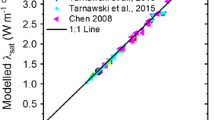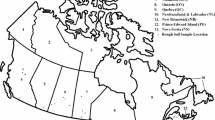Abstract
An advanced geometric mean model for predicting the effective thermal conductivity (\(\lambda \)) of unsaturated soils has been developed and successfully verified against an experimental \(\lambda \) database consisting of 40 Canadian soils, 15 American soils, 10 Chinese soils, four Japanese soils, three standard sands, and one pyroclastic soil (Pozzolana) from Italy (a total of 667 experimental \(\lambda \) entries). Three soil structure-based parameters were used in the model, namely an inter-particle thermal contact resistance factor (\(\alpha \)), the degree of saturation of a miniscule pore space \((s_{\mathrm{r}})\), and the bulk thermal conductivity of soil solids \((\lambda _{\mathrm{s}})\). The \(\alpha \) factor strongly depended on the ratio of \(\lambda _{\mathrm{s}}\) to \(\lambda _{\mathrm{f}}\) (where \(\lambda _{\mathrm{f}}\) is the thermal conductivity of interfacial fluid) and an inter-particle contact coefficient (\(\varepsilon \)) whose value was obtained by reverse modeling of experimental \(\lambda \) data of 40 Canadian soils; the average values of \(\varepsilon \) varied between 0.988 and 0.994 for coarse and fine soils, respectively. In general, \(\varepsilon \) depends on soil compaction, soil specific surface area, and grain size distribution. The use of \(\alpha \) was essential for close \(\lambda \) estimates of experimental data at a low range of degree of saturation \((S_{\mathrm{r}})\). For \(\lambda _{\mathrm{s}}\) estimates obtained from measured \(\lambda \) at soil saturation or a complete soil mineral composition data or experimental quartz content, 69 % of \(\lambda \) predictions were less than \(0.08\, \hbox {W} {\cdot } \hbox {m}^{-1} {\cdot } \hbox {K}^{-1}\), 15 % were between \(0.08\,\hbox {W} {\cdot } \hbox {m}^{-1} {\cdot } \hbox {K}^{-1}\) and \(0.13\,\hbox {W} {\cdot } \hbox {m}^{-1} {\cdot } \hbox {K}^{-1}\), and 13 % were between \(0.13\,\hbox {W} {\cdot } \hbox {m}^{-1} {\cdot } \hbox {K}^{-1}\) and \(0.24\,\hbox {W} {\cdot } \hbox {m}^{-1} {\cdot } \hbox {K}^{-1}\) with respect to experimental data \((\lambda _{\mathrm{exp}})\). The model gives close \(\lambda \) estimates with an average root-mean-square error (RMSE) of \(0.051\,\hbox {W} {\cdot } \hbox {m}^{-1} {\cdot } \hbox {K}^{-1}\) for 22 Canadian fine soils and an average RMSE of \(0.092\,\hbox {W} {\cdot } \hbox {m}^{-1} {\cdot } \hbox {K}^{-1}\) for 18 Canadian coarse soils. In general, better \(\lambda \) estimates were obtained for soils containing less content of quartz. Overall, the model estimates were good for all soils at dry state (\(\hbox {RMSE} = 0.050\, \hbox {W} {\cdot } \hbox {m}^{-1} {\cdot } \hbox {K}^{-1}\); 22 % of the average \(\lambda _{\mathrm{exp}}\)), saturated state (\(\hbox {RMSE} = 0.090\,\hbox {W} {\cdot } \hbox {m}^{-1} {\cdot } \hbox {K}^{-1}\); 5 % of the average \(\lambda _{\mathrm{exp}}\)), soil field capacity (\(\hbox {RMSE} = 0.105\,\hbox {W} {\cdot } \hbox {m}^{-1} {\cdot } \hbox {K}^{-1}\); 9 % of the average \(\lambda _{\mathrm{exp}}\)), and satisfactory near a critical degree of saturation, \(S_{\mathrm{r-cr}}\) (\(\hbox {RMSE} = 0.162\,\hbox {W} {\cdot } \hbox {m}^{-1} {\cdot } \hbox {K}^{-1}\); 26 % of the average \(\lambda _{\mathrm{exp}}\)).




















Similar content being viewed by others
References
O.T. Farouki, Thermal Properties of Soils (Trans Tech Publication, Durnten, 1986)
J. Côté, J.M. Konrad, Int. J. Heat Mass Transf. 52, 796 (2009)
V.R. Tarnawski, T. Momose, W.H. Leong, B. Wagner, in Proceedings of the ASME-ATI- UIT 2010 Conference on Thermal and Environmental Issues in Energy Systems, Sorrento, Italy (2010)
W. Woodside, J.H. Messmer, J. Appl. Phys. 32, 1688 (1961)
D.A. de Vries, Thermal Properties of Soils (Chap. 7), in Physics of Plant Environment, ed. by W.R. van Wijk (North-Holland, Amsterdam, 1963)
A.S. Judge, The thermal regime of the Mackenzie Valley. Observations of the natural state. Environmental Social Committee of Northern Pipelines, Report No. 73–38
H. Kiyohashi, M. Deguchi, High Temp. High Press. 30, 25 (1998)
V.R. Tarnawski, T. Momose, M.L. McCombie, W.H. Leong, Int. J. Thermophys. 36, 119 (2015)
W.O. Smith, Soil Sci. 53, 435 (1942)
R. McGaw, in Effects of Temperature and Heat on Engineering Behavior of Soils. Highway Research Board Special Report, vol. 103, p. 114 (1969)
L.D. Baver, W.H. Gardner, W.R. Gardner, Soil Phys. (Wiley, New York, 1972)
J. Sundberg, Thermal properties of soils and rocks. Geol. Inst. A57, 1–310 (1988)
V.R. Tarnawski, W.H. Leong, F. Gori, G.D. Buchan, J. Sundberg, Int. J. Energy Res. 26, 1345 (2002)
W.H. Leong, V.R. Tarnawski, F. Gori, G.D. Buchan, J. Sundberg, Int. J. Energy Res. 29, 131 (2005)
T.S. Yun, J.C. Santamarina, Granular Matter 10, 197 (2008)
G.A. Narsilio, T.S. Yun, J. Kress, T.M. Evans, IOP Conference Series: Materials Science and Engineering, vol. 10, p. 1 (2010)
Y. Dong, J.S. McCartney, N. Lu, Geotechnol. Geol. Eng. 33, 207 (2015)
K. McInnes, Thermal conductivities of soils from dryland wheat regions in Eastern Washington, MSc thesis, Washington State University (1981)
V.R. Tarnawski, W.H. Leong, Transp. Porous Media 41, 137 (2000)
W.O. Smith, Soil Sci. Soc. Am. Proc. 193(4), 32 (1939)
A.R. Sepaskhah, L. Boresma, Soil Sci. Soc. Am. J. 43, 439 (1979)
V.R. Tarnawski, W.H. Leong, Int. J. Thermophys. 33, 1191 (2012)
V.R. Tarnawski, T. Momose, W.H. Leong, Int. J. Thermophys. 32, 984 (2011)
V.R. Tarnawski, M.L. McCombie, W.H. Leong, B. Wagner, T. Momose, J. Schönenberger, Int. J. Thermophys. 33, 843 (2012)
F. Brigaud, G. Vasseur, Geophys. J. 98, 525 (1989)
Ch. Clauser, E. Huenges. Rock Physics & Phase Relations: A Handbook of Physical Constants, American Geophysical Union, pp. 105–126 (1995)
J. Schönenberger, T. Momose, B. Wagner, W.H. Leong, V.R. Tarnawski, Int. J. Thermophys. 33, 342 (2012)
S. Lu, T. Ren, Y. Gong, R. Horton, Soil Sci. Soc. Am. J. 71, 8 (2007)
V.R. Tarnawski, T. Momose, W.H. Leong, Geotechnique 59(4), 331 (2009)
T. Kasubuchi, T. Momose, F. Tsuchiya, V.R. Tarnawski, Transactions of Japanese Society of Irrigation. Drain. Reclam. Eng. 251, 53 (2007)
H. Mochizuki, I. Sakaguchi, M. Inoue, J. Jpn. Soc. Soil Phys. 93, 47–50 (2003)
G.S. Campbell, J.D. Jungbauer Jr, W.R. Bidlake, R.D. Hungerford, Soil Sci. 158(5), 307–313 (1994)
J.W. Hopmans, J.H. Dane, Soil Sci. 142(4), 187–195 (1986)
M.L. McCombie, G. Bovesecchi, P. Coppa, V.R. Tarnawski. Int. J. Thermophys. (submitted 2015)
V.R. Tarnawski, M.L. McCombie, T. Momose, I. Sakaguchi, W.H. Leong, Int. J. Thermophys. 34, 1130 (2013)
Acknowledgments
The authors are grateful to the Natural Sciences and Engineering Research Council of Canada and Saint Mary’s University for the funds provided to conduct this research and Mr. Marlon McCombie from Entiuum Energy Systems Inc. and Andra Motion Technologies Inc. (Canada) for his assistance in preparing the manuscript.
Author information
Authors and Affiliations
Corresponding author
Appendices
Appendix 1: Physical Characteristics and Thermal Conductivities of 40 Canadian Soils [8]
Appendix 2: Physical Characteristics and Thermal Conductivities of Ten Chinese Soils [28]
Appendix 3: Physical Characteristics and Thermal Conductivities of Four Japanese Soils [30, 31]
Appendix 4: Physical Characteristics and Thermal Conductivities of 15 American Soils
1.1 Five Soils from Eastern Washington (USA) [18]
1.2 Nine Soils from Eastern Washington and Alaska (USA) [32]
1.3 Thermal Conductivity of Norfolk [33]
Appendix 5: Physical Characteristics and Thermal Conductivity of Pozzolana (Italy) [34]
See Appendix Tables 24, 25 and 26.
Appendix 6: Physical Characteristics and Thermal Conductivities of Three Standard Sands [35]
Rights and permissions
About this article
Cite this article
Tarnawski, V.R., Leong, W.H. Advanced Geometric Mean Model for Predicting Thermal Conductivity of Unsaturated Soils. Int J Thermophys 37, 18 (2016). https://doi.org/10.1007/s10765-015-2024-y
Received:
Accepted:
Published:
DOI: https://doi.org/10.1007/s10765-015-2024-y




